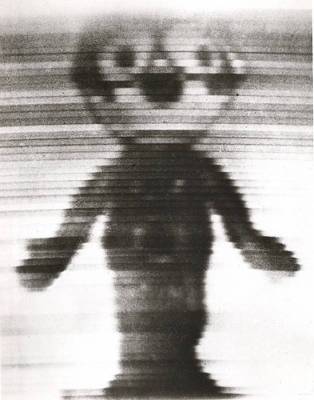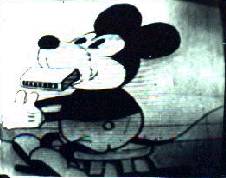Experimental TV Broadcasts Began in 1928 with this doll rotating on a record player !
THE Earliest RCA and NBC EXPERIMENTAL TELEVISION PROJECTS
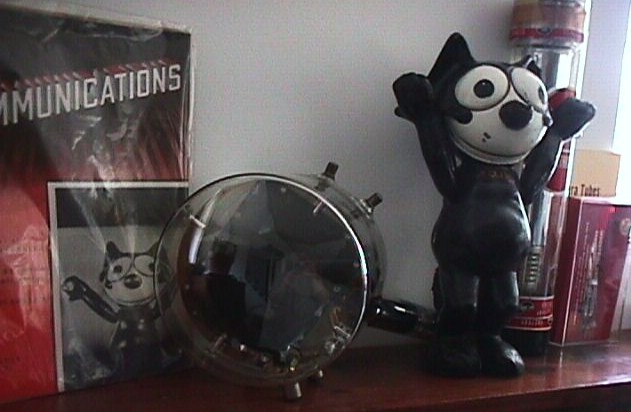 |
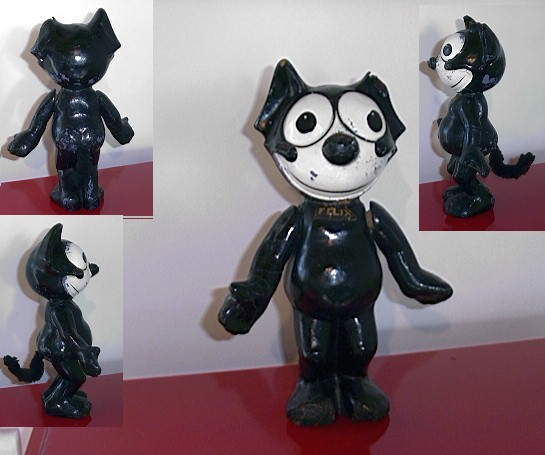 |
| Above Photographs are of the actual Felix Figure residing in my collection
|
RCA's first experimental television transmissions began in 1928 by station W2XBS
(New York-Channel #1) in Van Cortlandt Park and then moved to the New Amsterdam
Theater Building, transmitting 60 line pictures. A 13" Felix the Cat figure made of paper
mache was placed on a record player turntable and was broadcast using a mechanical scanning
disk to an electronic kinescope receiver. The image received was only 2 inches tall, and
the broadcasts lasted about 2 hours per day. By 1931 the station became part of NBC and
began to transmit from 42nd St. These early broadcasts consisted of objects like Felix the
Cat or early test patterns and photographs.
During the first half of 1932, an experimental television system had been used in New York
using a studio scanning apparatus. This consisted of a mechanical disk, flying-spot type,
for an image of 120 lines. Even for small areas of coverage and for 120 lines, the resulting
signal amplitude was unsatisfactory.
In the Camden system, an iconoscope was used as the pick-up device. The use of the
iconoscope permitted transmission of greater detail, outdoor pick-up, and wider areas of
coverage in the studio. Experience indicated that it provided a new degree of flexibility
in pick-up performance, thereby removing one of the most technical obstacles to television.1
After many years of research and development an all-electronic television system emerged
from the laboratory in 1933 for actual field tests. These tests were carried out at Camden
(New Jersey), using a video transmitter and connected to it by a coaxial line. Iconoscopes
(television cameras) were used to pick up scenes both in the studio and out-of-doors.
A scanning pattern of 240 lines made it possible to obtain a picture with good definition,
but as the frame frequency was 24 cycles, without interlacing , flicker was quite noticeable.
Dr. Vladimir Kosma Zworykin, who joined RCA in 1929 was in charge of television development
as the Director of Research. He kept personal photographic records that have just been
discovered and include important photographic images of previously unknown experiments.
The following year (1934) the number of lines was increased to 343, and an interlaced
pattern having a field frequency of 60 cycles and a repetition rate of 30 frames per second
was adopted. The results of these tests were so satisfactory that it was decided to
continue them in New York City, the site of earlier RCA tests using a mechanical scanner.
The advantage of the new location was that transmission studies under more nearly the
conditions encountered in actual broadcasts were possible, in particular, with respect to
noise and reflection from buildings. This move was made in 1935, tests followed the
following year. The New York studios were located in Radio City. The transmitter was
installed in one of the upper floors of the Empire State Building, with the antenna on the
mooring mast, 1285 feet above street level. Two links interconnect the studio and
transmitter. One of these is an underground coaxial cable approximately a mile in length.
An ultra-high-frequency radio relay link operating at 177 megacycles serves as (an)
alternative for interconnecting the two units. In order to increase the flexibility of the
system, and to permit outdoor and indoor pickup from remote points, a mobile unit consisting
of a pickup truck and transmitter, which operated at 177 megacycles, was placed in service
in 1938.
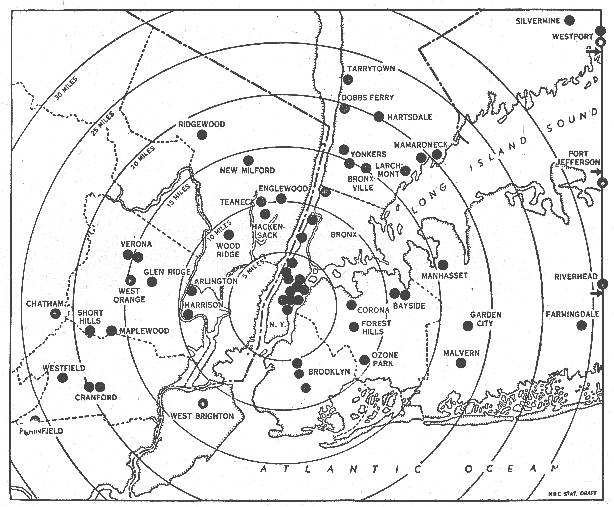 |
| 1937 New York, each dot represents one test receiver placed in the homes of NBC or RCA officers
|
Approximately one hundred receivers were built and located at various points
within a radius of 50 miles of the transmitter. These, together with field strength
measurements, gave detailed information as to the effect of the terrain on the received
pictures. They also facilitated obtaining data on the reaction of a great variety of
people to different types of programs. 2
1. E.W. Engstrom, "Television"; "An Experimental Television System"
RCA Institutes Technical Press, pp. 253-254, July, 1936.
2. V.K. Zworykin, G.A. Morton, "Television, The Electronics of Image Transmission," John Wiley & Sons, Inc., pp. 567-568, 1940
Growth of Television
| Year |
TV Sets in Use |
# Lines in Picture |
| 1928 & Earlier |
Few Experimental |
30 Lines |
| 1929 |
Few Experimental |
60 Lines |
| 1931 |
Few Experimental |
120 Lines |
| 1933 |
Few Experimental |
240 Lines |
| 1934 |
50-100 |
343 Lines |
| 1939 |
Less than 1,000 |
441 Lines |
| 1941 |
1,000 |
525 Lines |
| 1946 |
6,000 |
525 Lines |
| 1947 |
142,000 |
525 Lines |
| 1948 |
977,000 |
525 Lines |
| 1949 |
3,660,000 |
525 Lines |
| 1950 |
9,732,000 |
525 Lines |
| 1951 |
15,637,000 |
525 Lines |
| 1952 |
21,782,000 |
525 Lines |
| 1953 |
25,233,000 |
525 Lines |
Interesting facts:
- A pre World War II (1941) Television Set is rarer than a Stradivarius Violin!
- The number of televisions sold in the US for the month of September 2001 was 2.3 million!
Go to the MAIN PAGE
Felix The Cat Broadcast of 1929 |
Dr. Zworykin's Secret Experimental RCA Photos of 1933 |
First TV Dinner June 21, 1936 |
First Live TV Demo November 6, 1936 |
Public Sees TV at 1939 World's Fair |
Photo Card of Dr. Zworykin 1948 Topps |
Dr. Zworykin weds November 14, 1951 |
Dr. Zworykin dies July 29, 1982 |
eMail: Steve Restelli |
Sign:Guestbook |
Links |
Copyright 2016, The Restelli Collection has been visited  times, check back for future additions. Last update; 1-01-16
times, check back for future additions. Last update; 1-01-16

